Deborah Swift's Blog, page 37
August 6, 2014
The State of English Roads in the 17th Century
As Shadow on the Highway is about highway robbery, it features a lot of travel by horseback, so I thought I'd share some snippets of my research. Anyone with information to add to my growing collection of data about Stuart roads, I'd be glad to hear from you. Thanks to Hoydens and Firebrands, where this post was first published.
Even though it has been a dry summer, the roads near my house are full of pot-holes thanks to a wet winter and not much money spent on road maintenance. But how were roads and highways maintained in the Stuart Era?
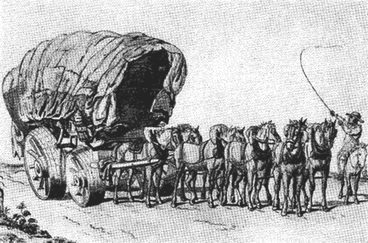
Most goods were transported from the ports to the interior of the country by pack horses and so tracks were the routes most commonly followed. There were no signposts in the 17th Century, so you had to either know the route already or employ a guide. Most roads passed through areas that were still deeply forested, and would in no way resemble the sort of roads we have now. In Henry VIII's reign the use of the heavy waggon and springless cart became more common, and as prosperity increased there was more need for wider roads. A large waggon was also more economical for transporting items in bulk. The dust surface of these new broad roads became mud in winter, and so in 1555 the Statute of Philip and Mary was passed which provided a strategy for maintaining the roads.
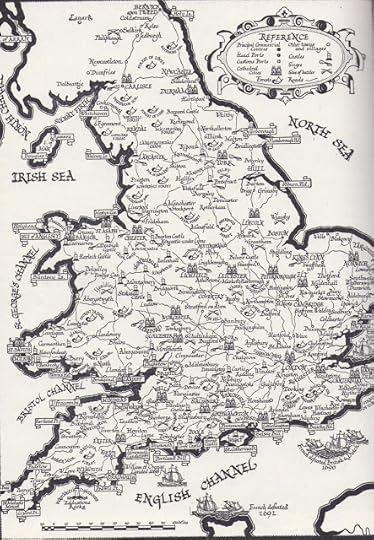 17th Century routes through the towns and forests
17th Century routes through the towns and forests
of England, hunting horns denote forestsThis act, which lasted right through Stuart times made the parish instead of the Lord of the Manor responsible for the upkeep of the highway. What this meant in effect was that if a road passed through your parish, it was your job to keep it in good condition. In order for this to work, each parish had to appoint a Surveyor of Highways. His duty was to inspect the road, and should it need work, he could call on each of the parishioners to do six days of road mending. Materials could be legally taken by the Surveyor from anyone's land for this task, and stones, rubble or earth removed without the landowner being recompensed for damage to the property. Naturally the Surveyor of Highways was not a popular person, as very few wanted to spend six days labouring and his inspections usually meant trouble as he took materials for repair from local landowners.
This system did not work particularly well and meant roads were often impassable in bad weather. Particularly bad were the routes in and out of the capital. But in 1656, tired of the responsibility of maintaining The Great North Road, the people of Radwell in Hertfordshire petitioned the Quarter Sessions for help, because this was the major route in and out of London. Probably as a result of this, Parliament passed a bill that gave the local justices powers to erect toll-gates on a section of the Great North Road for a trial period of eleven years, and allowed that the revenues collected should be used for the maintenance of the road.
This being a success, to assist in the repair of roads, after 1663 groups of wealthy landowners were given permission by Parliament to build or improve a stretch of road and then charge tolls to get their money back, thereby allowing them to make a profit. These were called Turnpike Trusts. At first these toll roads were short and acted as short cuts, often bypassing a village and thus reducing its trade.
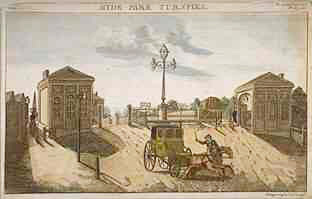 18thC print of Hyde Park Turnpike GateAt some places along main roads, houses and gates were set up and a tollgate keeper lived alongside the route. These turnpikes continued to multiply slowly until by 1872, when the system was finally abolished, there were approximately 8000 turnpikes in operation.
18thC print of Hyde Park Turnpike GateAt some places along main roads, houses and gates were set up and a tollgate keeper lived alongside the route. These turnpikes continued to multiply slowly until by 1872, when the system was finally abolished, there were approximately 8000 turnpikes in operation.
A turnpike gate was a large gate which revolved on a spike and after the individual had paid his penny to use the turnpike the gate would revolve allowing access to the newly created turnpike road. Typical charges in the 17th Century were one penny for a horse and sixpence for a coach. Exempt from the charges were mail coaches, foot passengers and people in a funeral cortege. Because it was possible for brave horsemen to leap over the gates without paying, the gate was sometimes replaced by what soon became known as a 'turnpike': a wooden bar with spikes on top.
Of course I will have to include this sort of a leap over a Turnpike in my next book!
Even though it has been a dry summer, the roads near my house are full of pot-holes thanks to a wet winter and not much money spent on road maintenance. But how were roads and highways maintained in the Stuart Era?

Most goods were transported from the ports to the interior of the country by pack horses and so tracks were the routes most commonly followed. There were no signposts in the 17th Century, so you had to either know the route already or employ a guide. Most roads passed through areas that were still deeply forested, and would in no way resemble the sort of roads we have now. In Henry VIII's reign the use of the heavy waggon and springless cart became more common, and as prosperity increased there was more need for wider roads. A large waggon was also more economical for transporting items in bulk. The dust surface of these new broad roads became mud in winter, and so in 1555 the Statute of Philip and Mary was passed which provided a strategy for maintaining the roads.
 17th Century routes through the towns and forests
17th Century routes through the towns and forestsof England, hunting horns denote forestsThis act, which lasted right through Stuart times made the parish instead of the Lord of the Manor responsible for the upkeep of the highway. What this meant in effect was that if a road passed through your parish, it was your job to keep it in good condition. In order for this to work, each parish had to appoint a Surveyor of Highways. His duty was to inspect the road, and should it need work, he could call on each of the parishioners to do six days of road mending. Materials could be legally taken by the Surveyor from anyone's land for this task, and stones, rubble or earth removed without the landowner being recompensed for damage to the property. Naturally the Surveyor of Highways was not a popular person, as very few wanted to spend six days labouring and his inspections usually meant trouble as he took materials for repair from local landowners.
This system did not work particularly well and meant roads were often impassable in bad weather. Particularly bad were the routes in and out of the capital. But in 1656, tired of the responsibility of maintaining The Great North Road, the people of Radwell in Hertfordshire petitioned the Quarter Sessions for help, because this was the major route in and out of London. Probably as a result of this, Parliament passed a bill that gave the local justices powers to erect toll-gates on a section of the Great North Road for a trial period of eleven years, and allowed that the revenues collected should be used for the maintenance of the road.
This being a success, to assist in the repair of roads, after 1663 groups of wealthy landowners were given permission by Parliament to build or improve a stretch of road and then charge tolls to get their money back, thereby allowing them to make a profit. These were called Turnpike Trusts. At first these toll roads were short and acted as short cuts, often bypassing a village and thus reducing its trade.
 18thC print of Hyde Park Turnpike GateAt some places along main roads, houses and gates were set up and a tollgate keeper lived alongside the route. These turnpikes continued to multiply slowly until by 1872, when the system was finally abolished, there were approximately 8000 turnpikes in operation.
18thC print of Hyde Park Turnpike GateAt some places along main roads, houses and gates were set up and a tollgate keeper lived alongside the route. These turnpikes continued to multiply slowly until by 1872, when the system was finally abolished, there were approximately 8000 turnpikes in operation.A turnpike gate was a large gate which revolved on a spike and after the individual had paid his penny to use the turnpike the gate would revolve allowing access to the newly created turnpike road. Typical charges in the 17th Century were one penny for a horse and sixpence for a coach. Exempt from the charges were mail coaches, foot passengers and people in a funeral cortege. Because it was possible for brave horsemen to leap over the gates without paying, the gate was sometimes replaced by what soon became known as a 'turnpike': a wooden bar with spikes on top.
Of course I will have to include this sort of a leap over a Turnpike in my next book!
Published on August 06, 2014 01:48
June 30, 2014
Historical Fiction - the problem of too many Elizabeths
My latest novel in progress features a cast of real historical characters most of which have the real name 'Elizabeth.' My main character is not called Elizabeth, but her mother is, and her sister. Her aunts on her mother's and father's side are also called Elizabeth, as is her employer for whom she works as a lady's companion.
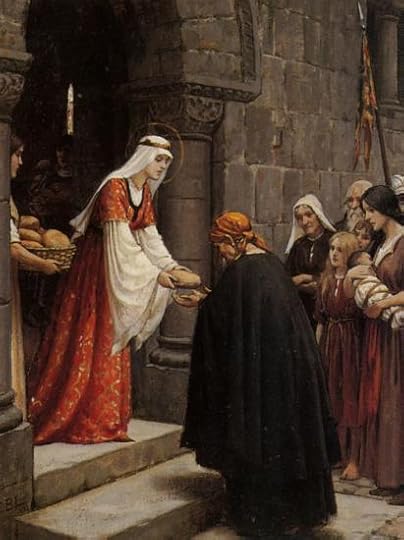 The Charity of St Elizabeth Of Hungary
The Charity of St Elizabeth Of Hungary Edmund Blair Leighton This is a real problem for historical novelists who are stuck with a cast of characters who all have the same name. I have taken the obvious way out which is to call them all by variants - so we have Aunt Beth, Aunt Eliza, Liddy, and yes, you've guessed it, Elisabeth (but spelled with an 's'.) Oh, and 'Mama' (who is also an Elizabeth, but I try to avoid using her actual name!)
Here are a few more common abbreviations that were used in the 17th and 18th centuries: Bess, Bessie, Beth, Betsy, Betty, Elisa, Eliza, Ella, Ellie, Elsa, Elsie, Elyse, Libby, Liddy, Lydia, Lilian, Lilibet, Lilibeth, Lillia, Lillian, Lisa, Lise, Lizbeth, Lizette, Lizzie, Lizzy, Tetty.
I imagine the general population had exactly the same trouble in knowing who was who, and that's why all the diminutives sprang up. But to add to 'Elizabeth mania', and not content with the English version, the pesky name crept into English at this time as these exotic variants as well:
Isabella (Spanish), Lise (Danish), Isabelle (French), Lisa (Dutch), Liliana, (Hungarian), Elísabet (Icelandic), Eilish, (Irish), Elisabetta, Liana, (Italian), Belinha, (Portuguese), Elspet, Elspeth, Ishbel, Isobel, Lileas, Lilias, Lillias (Scottish) and Bethan or Bethany (Welsh).
Originally Elizabeth was the Greek form of the Hebrew name 'Elisheva' meaning 'my God is my oath'. The name appears in the Bible in two variants, but Elizabeth as a name was originally far more common in Eastern Europe where the twelfth century saint, Elizabeth of Hungary, made it fashionable. She was a wealthy princess, daughter of King Andrew II, who used her riches to help the poor. One day during Mass she placed her crown on the altar as a sign of renunciation and to symbolise her humility and poverty. In 1228, she renounced her position and the world entirely, and took vows as a Franciscan penitent.
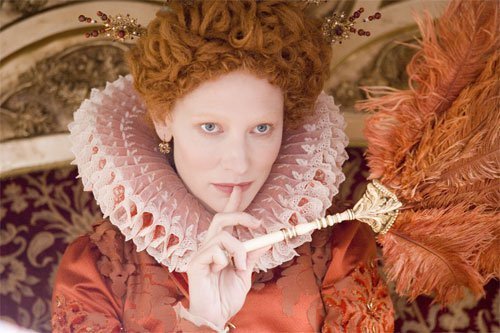 Cate Blanchett as Elizabeth IIn medieval England the name was occasionally used in honour of the saint, though the Spanish version, Isabel, was much more common, until of course England went to war with Spain. Then of course English parents preferred the version used by our own Queen Elizabeth I. The centuries following Elizabeth's reign led to a great flowering of Elizabeths, as parents wanted to bestow upon their girl children the health, wealth and wisdom of the deceased monarch. For centuries afterwards, during the Civil Wars and upheavals of the 17th century, Elizabeth's era was looked back upon as a Golden Age, and girls were named after her in the hope of her long life and good fortune - hence my problem!
Cate Blanchett as Elizabeth IIn medieval England the name was occasionally used in honour of the saint, though the Spanish version, Isabel, was much more common, until of course England went to war with Spain. Then of course English parents preferred the version used by our own Queen Elizabeth I. The centuries following Elizabeth's reign led to a great flowering of Elizabeths, as parents wanted to bestow upon their girl children the health, wealth and wisdom of the deceased monarch. For centuries afterwards, during the Civil Wars and upheavals of the 17th century, Elizabeth's era was looked back upon as a Golden Age, and girls were named after her in the hope of her long life and good fortune - hence my problem!
Published on June 30, 2014 04:45
June 25, 2014
The fiery #historical origin of the word 'curfew'
As a novelist fascinated by the past, I love it when I come across words that are linked to interesting historical facts. This week I came across a peculiar sort of fire guard called a 'couvre-feu' (french - cover fire). A little research revealed that this fire-guard was the origin of the word 'curfew' which I have often had to take account of in my seventeenth century novels. The word was also used to describe the time of the extinguishing of candles and lights. In Middle English it survived as "curfeu", which later became the modern "curfew". Originally, William the Conqueror decreed that all lights and fires should be put out at eight o'clock, but at the moment I am working on a novel based around Pepys's Diary, and in his day the curfew bell was rung at nine-o'clock.
The bell marked the end of an apprentice's working day. As they had to be rung manually, and finding someone to do it was often a problem, the apprentices made up this rhyme:
'Clarke of the Bow belle with the Yellow lockes,
For thy late ringing thy head shall have knockes'
The tolling of the curfew bell continued until Victorian times, when it was believed no longer necessary.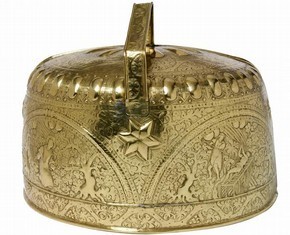 So what is this object, the 'couvre feu' ? Well it was a kind of metal dome that covered the embers of the fire when you retired for bed. Its purpose was to prevent a coal from tumbling out so that the fire could remain glowing overnight. The metal dome had a small hole cut in it so that bellows could be inserted in the morning to revive the fire. The one above, from the V&A Museum, is dutch and dated 1627.
So what is this object, the 'couvre feu' ? Well it was a kind of metal dome that covered the embers of the fire when you retired for bed. Its purpose was to prevent a coal from tumbling out so that the fire could remain glowing overnight. The metal dome had a small hole cut in it so that bellows could be inserted in the morning to revive the fire. The one above, from the V&A Museum, is dutch and dated 1627.
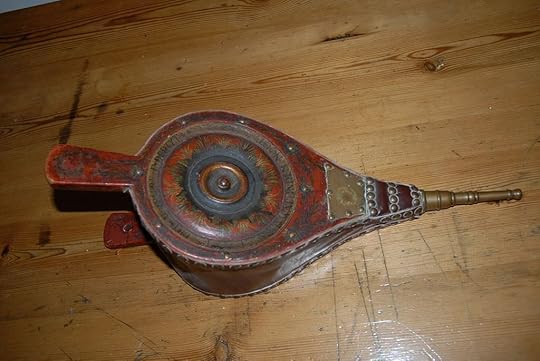
In those days curfews and bellows were very common household items as fires were so difficult to start, requiring flint and tinder and a lot of patience!
The bell marked the end of an apprentice's working day. As they had to be rung manually, and finding someone to do it was often a problem, the apprentices made up this rhyme:
'Clarke of the Bow belle with the Yellow lockes,
For thy late ringing thy head shall have knockes'
The tolling of the curfew bell continued until Victorian times, when it was believed no longer necessary.
 So what is this object, the 'couvre feu' ? Well it was a kind of metal dome that covered the embers of the fire when you retired for bed. Its purpose was to prevent a coal from tumbling out so that the fire could remain glowing overnight. The metal dome had a small hole cut in it so that bellows could be inserted in the morning to revive the fire. The one above, from the V&A Museum, is dutch and dated 1627.
So what is this object, the 'couvre feu' ? Well it was a kind of metal dome that covered the embers of the fire when you retired for bed. Its purpose was to prevent a coal from tumbling out so that the fire could remain glowing overnight. The metal dome had a small hole cut in it so that bellows could be inserted in the morning to revive the fire. The one above, from the V&A Museum, is dutch and dated 1627.

In those days curfews and bellows were very common household items as fires were so difficult to start, requiring flint and tinder and a lot of patience!
Published on June 25, 2014 11:45
June 5, 2014
Finding The Real Writer's Social Network
Like many writers I am attached to my computer for large chunks of the day whilst I imagine myself into a different time and place. Not only am I inhabiting other worlds than the real one for much of my working life, but I'm also making friends in another virtual world here on my blog, on Twitter and Facebook.
 That's two unreal worlds I am plugged into, let alone all the books I'm reading, which make a third.
That's two unreal worlds I am plugged into, let alone all the books I'm reading, which make a third.
It is easy to forget that none of these worlds are shared by the average person. When I was at my book group last week I happened to mention that authors could publish their books themselves. 'Really?' they said, 'you mean that anyone can publish a book? How?'
I explained about self-publishing and ebooks, and uploading, until they began to look slightly glazed. 'Oh,' one of them said. 'I might try that, one day, I have a little memoir that would be fun for my family to read.'
I was astonished. These are book people - readers that buy books regularly both on and offline, but they had never actually noticed that the publishing industry has changed. Then I realised. It is not that they are ill-informed, not at all. It's just that they live in the real world. A world in which where books come from - their creation, manufacture and sales - is pretty much irrelevant. Yes, they are readers for pleasure, but books are just the icing on the cake of life.
They represent the average reader who browses books in the way cattle graze grass, picking off the bits they fancy, with no undue concern about how the grass got there in the first place. These are the readers who are not book-obsessed enough to subscribe to book blogs, or hunt down authors on the web, or to stalk authors on Twitter. These, I think, are actually our sane book buying public. If they see a book they fancy in the Oxfam shop, they'll buy it, or they might pick it up in Tesco, or they'll borrow it from the library if someone they know mentions it as a good read. These are normal people who think of a platform as a place where they will catch a train.
A lot of them have kindles, but are not avidly following the daily deals. They wait until they have finished what they are reading, then cast about randomly for their next read. It is often luck which particular title comes into their path. So how does a writer reach them as potential readers? Not by Twitter, or Facebook or Blogging. These are the people who have lives, for heaven's sake!
[image error] I love my real networks, my book group, the people I meet at Tai Chi, the people in my local garden centre. I talk to them about books (not necessarily my books, but books in general) and I usually recommend something. The best publicity is word of mouth, so I tell people when I have really enjoyed a book. I hope that other people will do that for me if they have enjoyed one of mine. Recommending someone else's book (unlike touting your own) is pain-free, embarrassment free, and a good service to both the author and the reader.
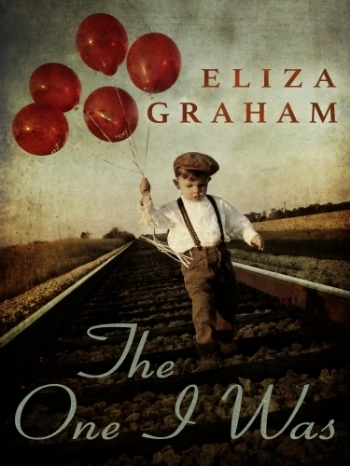 So here, for the sane book-buying public (who let's face it, are probably not reading my blog anyway, but are out at Pilates or Art Class or holding down a complicated and/or stressful job) are my recommendations for this week: BURIAL RITES by Hannah Kent and THE ONE I WAS by Eliza Graham
So here, for the sane book-buying public (who let's face it, are probably not reading my blog anyway, but are out at Pilates or Art Class or holding down a complicated and/or stressful job) are my recommendations for this week: BURIAL RITES by Hannah Kent and THE ONE I WAS by Eliza Graham
Historical literary fiction that is both gripping and engaging, although in this interview Hannah Kent claims to hate the term 'historical novel'! Bookbag review of The One I Was, a multi-generational roller-coaster of a novel that you won't want to put down.
 That's two unreal worlds I am plugged into, let alone all the books I'm reading, which make a third.
That's two unreal worlds I am plugged into, let alone all the books I'm reading, which make a third.It is easy to forget that none of these worlds are shared by the average person. When I was at my book group last week I happened to mention that authors could publish their books themselves. 'Really?' they said, 'you mean that anyone can publish a book? How?'
I explained about self-publishing and ebooks, and uploading, until they began to look slightly glazed. 'Oh,' one of them said. 'I might try that, one day, I have a little memoir that would be fun for my family to read.'
I was astonished. These are book people - readers that buy books regularly both on and offline, but they had never actually noticed that the publishing industry has changed. Then I realised. It is not that they are ill-informed, not at all. It's just that they live in the real world. A world in which where books come from - their creation, manufacture and sales - is pretty much irrelevant. Yes, they are readers for pleasure, but books are just the icing on the cake of life.
They represent the average reader who browses books in the way cattle graze grass, picking off the bits they fancy, with no undue concern about how the grass got there in the first place. These are the readers who are not book-obsessed enough to subscribe to book blogs, or hunt down authors on the web, or to stalk authors on Twitter. These, I think, are actually our sane book buying public. If they see a book they fancy in the Oxfam shop, they'll buy it, or they might pick it up in Tesco, or they'll borrow it from the library if someone they know mentions it as a good read. These are normal people who think of a platform as a place where they will catch a train.
A lot of them have kindles, but are not avidly following the daily deals. They wait until they have finished what they are reading, then cast about randomly for their next read. It is often luck which particular title comes into their path. So how does a writer reach them as potential readers? Not by Twitter, or Facebook or Blogging. These are the people who have lives, for heaven's sake!
[image error] I love my real networks, my book group, the people I meet at Tai Chi, the people in my local garden centre. I talk to them about books (not necessarily my books, but books in general) and I usually recommend something. The best publicity is word of mouth, so I tell people when I have really enjoyed a book. I hope that other people will do that for me if they have enjoyed one of mine. Recommending someone else's book (unlike touting your own) is pain-free, embarrassment free, and a good service to both the author and the reader.
 So here, for the sane book-buying public (who let's face it, are probably not reading my blog anyway, but are out at Pilates or Art Class or holding down a complicated and/or stressful job) are my recommendations for this week: BURIAL RITES by Hannah Kent and THE ONE I WAS by Eliza Graham
So here, for the sane book-buying public (who let's face it, are probably not reading my blog anyway, but are out at Pilates or Art Class or holding down a complicated and/or stressful job) are my recommendations for this week: BURIAL RITES by Hannah Kent and THE ONE I WAS by Eliza GrahamHistorical literary fiction that is both gripping and engaging, although in this interview Hannah Kent claims to hate the term 'historical novel'! Bookbag review of The One I Was, a multi-generational roller-coaster of a novel that you won't want to put down.
Published on June 05, 2014 03:49
May 18, 2014
No Quick Fix - The Inherent Complexity of a Novel
Recently I have noticed that there has been a tsunami of 'How to' writing guides published, and that these are selling extremely well. In fact it is probably more profitable, and perhaps easier, to write a book about writing a novel than it is to write a successful novel.
In fact that must be so - because so many people are turning to these books for help.The titles are designed to make it sound easy: Fix your Plot in Five Seconds Flat! Be a Billionaire Bestseller in 30 Days! Secrets of Fail-safe Story Structures!
 These books are designed to make it sound easy because that's what every novelist wants - an easy way to do this thing called writing a novel.But the reality is that good novels are complex, intricate, difficult things, and just like life, a formula is not necessarily what creates a great novel, particularly for historical novelists who have to juggle the reality of real historical events alongside any story structure. It is a slightly more thorny task to suddenly 'create' a worthy antagonist if the real history does not provide one. We cannot turn real characters into easily categorized roles in our novels, so have to work hard to fit our stories easily into conventional models, turning instead to internal motivations to create opposing forces.
These books are designed to make it sound easy because that's what every novelist wants - an easy way to do this thing called writing a novel.But the reality is that good novels are complex, intricate, difficult things, and just like life, a formula is not necessarily what creates a great novel, particularly for historical novelists who have to juggle the reality of real historical events alongside any story structure. It is a slightly more thorny task to suddenly 'create' a worthy antagonist if the real history does not provide one. We cannot turn real characters into easily categorized roles in our novels, so have to work hard to fit our stories easily into conventional models, turning instead to internal motivations to create opposing forces.
It is not true, however, to say that good story structure has to be thrown out of the window, and that none of these books on writing have anything to offer. On the contrary, I'm a big fan of books on writing. But reading the book is often not the same as editing something with multiple timelines, events that must take place on certain days, or characters who are known to be a certain way because of genuine evidence. Such a journey is more like negotiating a maze of corridors with light somewhere at the end of the tunnel, but not necessarily where you thought the exit was.
I would argue that good novels are complex, that they weave a number of interlocking themes, ideas and plots. When working on a novel the urge to get it finished by an easy solution can be overwhelming, but rather than looking for a 'quick fix' it is often better to sit with the complexities, let them simmer and brew, making your novel that much richer and subtler in the process. Anyone will find it easy to apply story structure to a novel after it is finished - to point out the mid-point, the hook etc etc. But the simple structures may have been a lot less easy to spot whilst the novel was in progress, and too often in desperation to see our novels finished, we want to fix them too early, before they have had a chance to breathe.
In order to sell books, it is argued, we must be more productive, to build our readership more quickly. This can induce a panic (and a vague sense of being bullied) to produce more and more books, but does not necessarily mean that the books are better. A readership is not built on bad books. I would argue that like wine, a good novel needs to be matured. A book like Shantaram or The Far Pavilions both at nearly 1000 pages long, (yes, 1000 pages!) surely cannot be produced quickly. The Pillars of the Earth, by Ken Follett, a historical novel about the time of the building of cathedrals in England, took about 10 years to write, but has stayed popular with readers ever since.
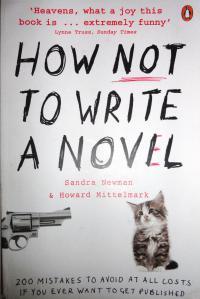
For those of you who still would like a quick fix (I can't convince you, can I?) then I heartily recommend 'How not to write a novel' by Sandra Newman and Howard Mittelmark, which not only avoids telling you what to do, but shows you what NOT to do through a series of hilarious but cleverly-constructed 'bad writing' examples. When you are feeling like you need a quick fix, pick this up instead and sift through your novel for similar cringeworthy examples. Total gold.
In fact that must be so - because so many people are turning to these books for help.The titles are designed to make it sound easy: Fix your Plot in Five Seconds Flat! Be a Billionaire Bestseller in 30 Days! Secrets of Fail-safe Story Structures!
 These books are designed to make it sound easy because that's what every novelist wants - an easy way to do this thing called writing a novel.But the reality is that good novels are complex, intricate, difficult things, and just like life, a formula is not necessarily what creates a great novel, particularly for historical novelists who have to juggle the reality of real historical events alongside any story structure. It is a slightly more thorny task to suddenly 'create' a worthy antagonist if the real history does not provide one. We cannot turn real characters into easily categorized roles in our novels, so have to work hard to fit our stories easily into conventional models, turning instead to internal motivations to create opposing forces.
These books are designed to make it sound easy because that's what every novelist wants - an easy way to do this thing called writing a novel.But the reality is that good novels are complex, intricate, difficult things, and just like life, a formula is not necessarily what creates a great novel, particularly for historical novelists who have to juggle the reality of real historical events alongside any story structure. It is a slightly more thorny task to suddenly 'create' a worthy antagonist if the real history does not provide one. We cannot turn real characters into easily categorized roles in our novels, so have to work hard to fit our stories easily into conventional models, turning instead to internal motivations to create opposing forces.It is not true, however, to say that good story structure has to be thrown out of the window, and that none of these books on writing have anything to offer. On the contrary, I'm a big fan of books on writing. But reading the book is often not the same as editing something with multiple timelines, events that must take place on certain days, or characters who are known to be a certain way because of genuine evidence. Such a journey is more like negotiating a maze of corridors with light somewhere at the end of the tunnel, but not necessarily where you thought the exit was.
I would argue that good novels are complex, that they weave a number of interlocking themes, ideas and plots. When working on a novel the urge to get it finished by an easy solution can be overwhelming, but rather than looking for a 'quick fix' it is often better to sit with the complexities, let them simmer and brew, making your novel that much richer and subtler in the process. Anyone will find it easy to apply story structure to a novel after it is finished - to point out the mid-point, the hook etc etc. But the simple structures may have been a lot less easy to spot whilst the novel was in progress, and too often in desperation to see our novels finished, we want to fix them too early, before they have had a chance to breathe.
In order to sell books, it is argued, we must be more productive, to build our readership more quickly. This can induce a panic (and a vague sense of being bullied) to produce more and more books, but does not necessarily mean that the books are better. A readership is not built on bad books. I would argue that like wine, a good novel needs to be matured. A book like Shantaram or The Far Pavilions both at nearly 1000 pages long, (yes, 1000 pages!) surely cannot be produced quickly. The Pillars of the Earth, by Ken Follett, a historical novel about the time of the building of cathedrals in England, took about 10 years to write, but has stayed popular with readers ever since.

For those of you who still would like a quick fix (I can't convince you, can I?) then I heartily recommend 'How not to write a novel' by Sandra Newman and Howard Mittelmark, which not only avoids telling you what to do, but shows you what NOT to do through a series of hilarious but cleverly-constructed 'bad writing' examples. When you are feeling like you need a quick fix, pick this up instead and sift through your novel for similar cringeworthy examples. Total gold.
Published on May 18, 2014 03:32
April 27, 2014
Throwing mud at a wall - my foolproof writer's process
Charlotte Betts is another fan of the seventeenth century and writes fantastic award-winning romantic novels set in the Restoration period. She invited me to take part in this writing process blog hop and you can find her blog on her writing process here:I have done my best to answer the set questions, though it is very tempting to meander off the point!What am I working on?
[image error]
I'm working on two things, one a big thick adult novel, and the other a slimmer title suitable for young adults as well as my adult readers. The big novel is a novel based around Pepys's diary. I have used Pepys's Diary for so many years as reference material for my other books that I just could not resist! It tells the story of Pepys's most famous obsession, his wife's companion Deborah Willett. I have to say, it does feel slightly odd writing about someone with the same first name. Fortunately Pepys himself soon shortens it to Deb, which feels a little more comfortable!The second smaller novel is part of a series of novellas based around the life of highwaywoman and royalist Lady Katherine Fanshawe - see my previous post. The first volume was told from the point of view of her deaf maid, and is awaiting editing. I'm on the second volume now which includes the Battle of Worcester in the English Civil War, and is written from the point of view of a ghost. This is a slightly scary thing to do, but very enjoyable. I turn to that when I get stuck with the big book, or at night when it's dark!How does my work differ from others of its genre?Rather than writing about Kings or Queens - immensely popular in historical fiction, just look at those shelves groaning with books called 'The Queen's ---' (fill in the blank, but no, The Queen's Doughnut' is not acceptable) - my books are written about ordinary people. I love reading those books about royals though, I recently read 'The Queen's Exiles' by Barbara Kyle and it was a wonderful read.
When I say ordinary, that doesn't mean the characters are dull, in fact the opposite. They are the movers and shakers that shift society into different ways of thinking. I like to have multiple points of view in my novel, so that a broader view of the historical period is painted for the reader. I often write from the male as well as female perspective, so male readers are often pleasantly surprised to find that the book works for them too.
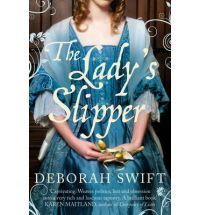 My books embrace themes that matter to me. For example the underlying question in The Lady's Slipper is: who owns what grows on the land? Is territory something worth fighting for? The setting of the English Civil War, and the battle for the lady's-slipper orchid's survival meshed perfectly together to explore these themes. My other two novels, equally, are underpinned by ideas that I wanted to look into for myself. I enjoy meaty, complex reads with adventure and romance and a strong sense of atmosphere, so I expect that's what I'm trying to produce!
My books embrace themes that matter to me. For example the underlying question in The Lady's Slipper is: who owns what grows on the land? Is territory something worth fighting for? The setting of the English Civil War, and the battle for the lady's-slipper orchid's survival meshed perfectly together to explore these themes. My other two novels, equally, are underpinned by ideas that I wanted to look into for myself. I enjoy meaty, complex reads with adventure and romance and a strong sense of atmosphere, so I expect that's what I'm trying to produce!
Why do I write what I do?I fell into writing historical novels by accident, when I was studying for an MA. The first novel started as a writing exercise, but it just kept on growing! By then I'd found that I loved it. Historical fiction uses some of the skills I learned in my previous job as a designer for stage and TV, such as the ability to reearch and plan, and manage my own time, and the ability to think around insurmountable problems (essential when plotting!). I am passionate about the past, and love anything old and interesting. My ideal day out would encompass a visit to a historic house or museum or archives, followed by afternoon tea (with scones and jam, naturally!). When I launched A Divided Inheritance we had exactly that sort of afternoon at Leighton Hall, and I hope my guests enjoyed it as much as I did.
How does your writing process work?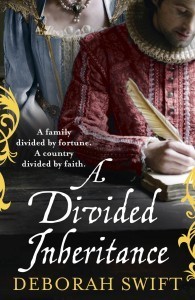 I wish I knew! To be honest I'm a bit chaotic whilst I'm writing. I'm like a magpie, picking up scraps of this and that and scribbling snippets in notebooks. I have a big batch of research books and far too many 'favourites' on my google task bar, of things I am reading as part of the initial 'throw mud at a wall' process. I'm also really motivated by pictures, so I collect a mass of visual information, postcards, and more web favourites. This can take a few months, but happens whilst I am finishing and editing the previous books. Only by doing this can I know if I have enough material and interesting stuff to sustain a long novel and eighteen months worth of research and writing.
I wish I knew! To be honest I'm a bit chaotic whilst I'm writing. I'm like a magpie, picking up scraps of this and that and scribbling snippets in notebooks. I have a big batch of research books and far too many 'favourites' on my google task bar, of things I am reading as part of the initial 'throw mud at a wall' process. I'm also really motivated by pictures, so I collect a mass of visual information, postcards, and more web favourites. This can take a few months, but happens whilst I am finishing and editing the previous books. Only by doing this can I know if I have enough material and interesting stuff to sustain a long novel and eighteen months worth of research and writing.
After this, some of the mud sticks (I hope!) and I start to draft. At this point I have a solid idea of the story, and the historical basis for it, but no details. On my word doc I lay out arbitrary chapter headings and start to fill in the detail. My first draft is what other people might call an outline, and it follows the chronology of the real history I'm writing about. But - if there are scenes that excite me I can't resist having a go at writing them, so I don't torture myself, I just go ahead and do it. Once I've done that sort of a draft, with some scenes fully written and others just noted as 'Chapter 5 - Mother dies', I'm ready for a second go at it. In this draft I try to fathom out how to make the scenes I haven't written yet more interesting or gripping until I have to write them. This involves more research and book gathering and tinkering with the plot. And so it goes on, draft after draft. The actual writing is like re-living the scene as I put it onto the screen. Eventually I end up with a full novel, all of which I enjoyed writing. At this point I'll put it away and work on something else for a bit to get distance.When I pick it up again I start editing, and this sometimes involves re-structuring and sometimes only nit-picking. Mostly it is about re-ordering the story into a logical flow. This is the point where I realise what the novel is really about, so I go back through it again and re-write with that in mind.
 So you can see, it is not exactly a quick, streamlined process, but it's more of an organic building-up over time, where the plot events accrue significance as I'm working.
So you can see, it is not exactly a quick, streamlined process, but it's more of an organic building-up over time, where the plot events accrue significance as I'm working.
I wish I could be the sort of person who sits down with a perfect plan and writes to it, but I'm just not. Initial ideas are always the most obvious ones - I need the juxtaposition of a lot of different stimuli to delve deep enough and make the right sort of connections to get a juicy story.This is why I think I'd be hopeless at writing crime - where I expect you have to know exactly who has done it from the outset, and why, and everyone's alibis! My method gives me a lot of 'wiggle-room' if I find a better or more interesting idea. I do love books on the craft of writing though, and fantasising that I'll be that super-efficient writing machine next time. . .
Next week Eli[image error]za Graham will be taking up the baton to tell us about her writing process.Eliza Graham writes historical fiction under the pen name Anna Lisle. She also writes fiction set in contemporary times but with a historical twist. Her most recent book is The One I Was.The One I Was1939. Youngster Benny Gault, a Kindertransport refugee from Nazi Germany’s anti-semiticism, arrives at Harwich docks, label flapping round his neck, football under his arm, and a guilty secret in his heart. More than half a century later, Benny lies on his deathbed in his beautiful country house, Fairfleet, his secret still unconfessed. Rosamond, his nurse, has a guilty secret of her own concerning her mother’s death in a fire at Fairfleet, years earlier. As Benny and Rosamond unwind the threads binding them together, Rosamond must fight the unfinished violence of the past, now menacing both Fairfleet's serenity and Benny's last days.The One I Was is a novel about shifting identities and whether we can truly reinvent ourselves.
When I say ordinary, that doesn't mean the characters are dull, in fact the opposite. They are the movers and shakers that shift society into different ways of thinking. I like to have multiple points of view in my novel, so that a broader view of the historical period is painted for the reader. I often write from the male as well as female perspective, so male readers are often pleasantly surprised to find that the book works for them too.
 My books embrace themes that matter to me. For example the underlying question in The Lady's Slipper is: who owns what grows on the land? Is territory something worth fighting for? The setting of the English Civil War, and the battle for the lady's-slipper orchid's survival meshed perfectly together to explore these themes. My other two novels, equally, are underpinned by ideas that I wanted to look into for myself. I enjoy meaty, complex reads with adventure and romance and a strong sense of atmosphere, so I expect that's what I'm trying to produce!
My books embrace themes that matter to me. For example the underlying question in The Lady's Slipper is: who owns what grows on the land? Is territory something worth fighting for? The setting of the English Civil War, and the battle for the lady's-slipper orchid's survival meshed perfectly together to explore these themes. My other two novels, equally, are underpinned by ideas that I wanted to look into for myself. I enjoy meaty, complex reads with adventure and romance and a strong sense of atmosphere, so I expect that's what I'm trying to produce!Why do I write what I do?I fell into writing historical novels by accident, when I was studying for an MA. The first novel started as a writing exercise, but it just kept on growing! By then I'd found that I loved it. Historical fiction uses some of the skills I learned in my previous job as a designer for stage and TV, such as the ability to reearch and plan, and manage my own time, and the ability to think around insurmountable problems (essential when plotting!). I am passionate about the past, and love anything old and interesting. My ideal day out would encompass a visit to a historic house or museum or archives, followed by afternoon tea (with scones and jam, naturally!). When I launched A Divided Inheritance we had exactly that sort of afternoon at Leighton Hall, and I hope my guests enjoyed it as much as I did.
How does your writing process work?
 I wish I knew! To be honest I'm a bit chaotic whilst I'm writing. I'm like a magpie, picking up scraps of this and that and scribbling snippets in notebooks. I have a big batch of research books and far too many 'favourites' on my google task bar, of things I am reading as part of the initial 'throw mud at a wall' process. I'm also really motivated by pictures, so I collect a mass of visual information, postcards, and more web favourites. This can take a few months, but happens whilst I am finishing and editing the previous books. Only by doing this can I know if I have enough material and interesting stuff to sustain a long novel and eighteen months worth of research and writing.
I wish I knew! To be honest I'm a bit chaotic whilst I'm writing. I'm like a magpie, picking up scraps of this and that and scribbling snippets in notebooks. I have a big batch of research books and far too many 'favourites' on my google task bar, of things I am reading as part of the initial 'throw mud at a wall' process. I'm also really motivated by pictures, so I collect a mass of visual information, postcards, and more web favourites. This can take a few months, but happens whilst I am finishing and editing the previous books. Only by doing this can I know if I have enough material and interesting stuff to sustain a long novel and eighteen months worth of research and writing.After this, some of the mud sticks (I hope!) and I start to draft. At this point I have a solid idea of the story, and the historical basis for it, but no details. On my word doc I lay out arbitrary chapter headings and start to fill in the detail. My first draft is what other people might call an outline, and it follows the chronology of the real history I'm writing about. But - if there are scenes that excite me I can't resist having a go at writing them, so I don't torture myself, I just go ahead and do it. Once I've done that sort of a draft, with some scenes fully written and others just noted as 'Chapter 5 - Mother dies', I'm ready for a second go at it. In this draft I try to fathom out how to make the scenes I haven't written yet more interesting or gripping until I have to write them. This involves more research and book gathering and tinkering with the plot. And so it goes on, draft after draft. The actual writing is like re-living the scene as I put it onto the screen. Eventually I end up with a full novel, all of which I enjoyed writing. At this point I'll put it away and work on something else for a bit to get distance.When I pick it up again I start editing, and this sometimes involves re-structuring and sometimes only nit-picking. Mostly it is about re-ordering the story into a logical flow. This is the point where I realise what the novel is really about, so I go back through it again and re-write with that in mind.
 So you can see, it is not exactly a quick, streamlined process, but it's more of an organic building-up over time, where the plot events accrue significance as I'm working.
So you can see, it is not exactly a quick, streamlined process, but it's more of an organic building-up over time, where the plot events accrue significance as I'm working.I wish I could be the sort of person who sits down with a perfect plan and writes to it, but I'm just not. Initial ideas are always the most obvious ones - I need the juxtaposition of a lot of different stimuli to delve deep enough and make the right sort of connections to get a juicy story.This is why I think I'd be hopeless at writing crime - where I expect you have to know exactly who has done it from the outset, and why, and everyone's alibis! My method gives me a lot of 'wiggle-room' if I find a better or more interesting idea. I do love books on the craft of writing though, and fantasising that I'll be that super-efficient writing machine next time. . .
Next week Eli[image error]za Graham will be taking up the baton to tell us about her writing process.Eliza Graham writes historical fiction under the pen name Anna Lisle. She also writes fiction set in contemporary times but with a historical twist. Her most recent book is The One I Was.The One I Was1939. Youngster Benny Gault, a Kindertransport refugee from Nazi Germany’s anti-semiticism, arrives at Harwich docks, label flapping round his neck, football under his arm, and a guilty secret in his heart. More than half a century later, Benny lies on his deathbed in his beautiful country house, Fairfleet, his secret still unconfessed. Rosamond, his nurse, has a guilty secret of her own concerning her mother’s death in a fire at Fairfleet, years earlier. As Benny and Rosamond unwind the threads binding them together, Rosamond must fight the unfinished violence of the past, now menacing both Fairfleet's serenity and Benny's last days.The One I Was is a novel about shifting identities and whether we can truly reinvent ourselves.
Published on April 27, 2014 09:18
April 13, 2014
#histfic Meet my main character - Lady Katherine Fanshawe
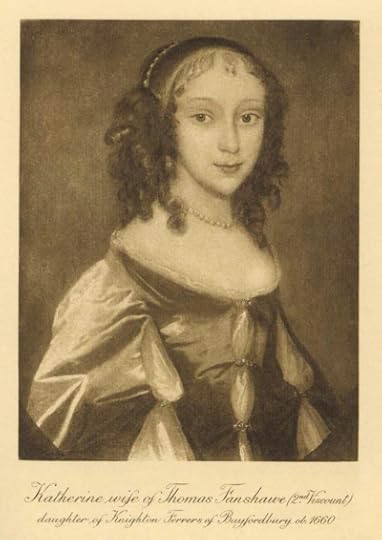 This post is part of a game begun by Debra Brown and passed to me by Sue Millard who lives relatively near me in Cumbria in the North of England.
This post is part of a game begun by Debra Brown and passed to me by Sue Millard who lives relatively near me in Cumbria in the North of England.The posts are designed for readers to gain an insight into what writers are working on at the moment. Because my book is part of a series and all the books aren't finished there are some details I don't want to reveal yet, but here is an inkling of what has been taking up my time since I finished 'A Divided Inheritance.'
What is the name of your character?My main character is seventeen-year-old Lady Katherine Fanshawe. She is a real historical person but also she features in a legend about her double life as noble lady and as a notorious highwaywoman. Find out more about the real person and the legend of The Wicked Lady here
When and where is the story set?I'll be taking you back in time to the English Civil Wars, in the mid seventeenth century, a time so turbulent it was known as 'the world turn'd upside down.'
What should we know about Lady Katherine Fanshawe?She comes from an illustrious and noble family but when she loses her parents she is forced by her stepfather to marry his lacklustre nephew. This enables her stepfather, Sir Stephen Fanshawe to take control over her land and wealth. She is rebellious, and takes to a secret life of highway robbery to replace her lost fortune.
What is the main conflict she must face?Whilst disguised as a maid she falls in love with local boy, Ralph Chaplin. Ralph is determined to build a new world in which everyone is equal, where there is no aristocracy, following the ideals of the Digger movement. Ralph hates the nobility and would be horrified to find the girl he thinks of as 'Kate' is really Lady Katherine Fanshawe. He would be even more horrified if he knew what she got up to at night!
What is the personal goal of this character?Kate is courageous and craves adventure and danger, but often does not look before she leaps. She is determined to escape her controlling stepfather, to be free of society's demands, and to love who she pleases. At the same time she is reluctant to give up the life in which her status gives her privileges and she definitely does not want to give up ordering people about!
When will this book be published?Actually, this is three books - a series of three novellas, which make up The Highway Trilogy. This is a set of books suitable for adults and young adults of 14+. Each book is about 200 pages. The first book is told from the point of view of Lady Katherine's feisty maid, Abigail, the second from Ralph Chaplin's point of view, and the third from Lady Katherine's (Kate's) point of view. I thought it would be fun to write some shorter books for young adults in between my bigger books.
Publication date yet to be confirmed. The working title of the first book in the series is 'Shadow on the Highway', the next one will be 'Ghost on the Highway,' and the third 'Revenge on the Highway.'Pictures relating to the books are on my Pinterest Site
Now I need to pass the baton on to these lovely historical fiction writers:Charlotte BettsAnita SeymourCarol Cram
Published on April 13, 2014 08:13
March 22, 2014
Powerful drama of a King's Execution - The Crimson Ribbon
[image error]
Blurb:Based on the real figure of the fascinating Elizabeth Poole, The Crimson Ribbon is the mesmerising story of two women's obsession, superstition and hope.
May Day 1646. The Civil War is raging and what should be a rare moment of blessing for the town of Ely takes a brutal turn. Ruth Flowers is left with little choice but to flee the household of Oliver Cromwell, the only home she has ever known. On the road to London, Ruth sparks an uneasy alliance with a soldier, the battle-scarred and troubled Joseph. But when she reaches the city, it's in the Poole household that she finds refuge.
Lizzie Poole, beautiful and charismatic, enthrals the vulnerable Ruth, who binds herself inextricably to Lizzie's world. But in these troubled times, Ruth is haunted by fears of her past catching up with her. And as Lizzie's radical ideas escalate, Ruth finds herself carried to the heart of the country's conflict, to the trial of a king.
I received this book for review from the Amazon Vine programme because I love the seventeenth century and it looked like my sort of book. I was not disappointed.The story of Elizabeth Poole and her role as witness to the beheading of a King is brought masterfully to life in this gripping drama. Told through the eyes of Ruth Flowers who is on the run to escape a witch hunt, the book draws the reader gradually into the uneasy, fragile world of desperate people looking for an answer to the bloodshed of the English Civil Wars. Elizabeth Poole herself remains an enigma, shedding layers of shifting truths that make the reader unsure who or what she is. Is Elizabeth a sinner or a saint? Ruth's devotion to her, though not fully explained, is both her salvation and her downfall.
Although it only uses historical events as a kind of backdrop to the story I found the historical background to be well-researched and atmospheric. But the strength of this novel is in the portayal of the ever-changing relationship between Ruth and Lizzie, and the writer's ability to take you fully into the mindset of a nation which can try a King for treason against his own country.
I look forward to more books from this debut novelist, Katherine Clements. For comparison you might like to try 'As Meat Loves Salt' by Maria McCann which tells of a similar obsessive relationship between two men, and is one of my favourite reads about this period.
[image error]
Blurb:Based on the real figure of the fascinating Elizabeth Poole, The Crimson Ribbon is the mesmerising story of two women's obsession, superstition and hope.
May Day 1646. The Civil War is raging and what should be a rare moment of blessing for the town of Ely takes a brutal turn. Ruth Flowers is left with little choice but to flee the household of Oliver Cromwell, the only home she has ever known. On the road to London, Ruth sparks an uneasy alliance with a soldier, the battle-scarred and troubled Joseph. But when she reaches the city, it's in the Poole household that she finds refuge.
Lizzie Poole, beautiful and charismatic, enthrals the vulnerable Ruth, who binds herself inextricably to Lizzie's world. But in these troubled times, Ruth is haunted by fears of her past catching up with her. And as Lizzie's radical ideas escalate, Ruth finds herself carried to the heart of the country's conflict, to the trial of a king.
I received this book for review from the Amazon Vine programme because I love the seventeenth century and it looked like my sort of book. I was not disappointed.The story of Elizabeth Poole and her role as witness to the beheading of a King is brought masterfully to life in this gripping drama. Told through the eyes of Ruth Flowers who is on the run to escape a witch hunt, the book draws the reader gradually into the uneasy, fragile world of desperate people looking for an answer to the bloodshed of the English Civil Wars. Elizabeth Poole herself remains an enigma, shedding layers of shifting truths that make the reader unsure who or what she is. Is Elizabeth a sinner or a saint? Ruth's devotion to her, though not fully explained, is both her salvation and her downfall.
Although it only uses historical events as a kind of backdrop to the story I found the historical background to be well-researched and atmospheric. But the strength of this novel is in the portayal of the ever-changing relationship between Ruth and Lizzie, and the writer's ability to take you fully into the mindset of a nation which can try a King for treason against his own country.
I look forward to more books from this debut novelist, Katherine Clements. For comparison you might like to try 'As Meat Loves Salt' by Maria McCann which tells of a similar obsessive relationship between two men, and is one of my favourite reads about this period.
[image error]
Published on March 22, 2014 05:23
March 9, 2014
The Ideal Home of 1609
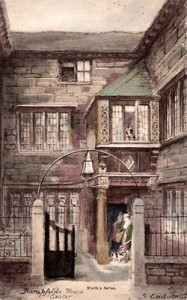 In A Divided Inheritance, Elspet Leviston stands to lose her family’s house and business to a cousin she never knew existed. To recreate the house in my mind I researched the late Elizabethan and Early Jacobean style – a period much overlooked, but with its own distinct characteristics.
In A Divided Inheritance, Elspet Leviston stands to lose her family’s house and business to a cousin she never knew existed. To recreate the house in my mind I researched the late Elizabethan and Early Jacobean style – a period much overlooked, but with its own distinct characteristics.Elspet lives in London and her house has been in the family for generations, so it is likely that the actual fabric of the building would have been Tudor or even earlier, but with more modern furnishings. She also tells us in the novel that her father is quite reluctant to update the house – to buy new drapes or replace worn items. Westview House in the novel would be quite shabby, but with good quality furniture. In the picture below of Crewe Hall, notice the typical ceiling of the period with its pendant plasterwork, which would soon have grown grubby from the smoking fires and tobacco.
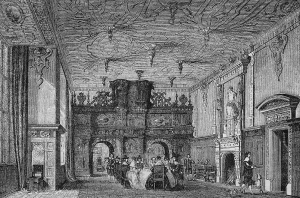 Crewe Hall Dining RoomI used a real house to model Elspet’s home on. I find it much easier to write if I have a good sense of the geography of a house and a real picture of where doors, windows and so forth would have been. I couldn’t find a suitable house in London of the right middling size, though I used the street map of the time to locate where the house would have stood. Much of this area of London was lost in the subsequent Great Fire of 1666.
Crewe Hall Dining RoomI used a real house to model Elspet’s home on. I find it much easier to write if I have a good sense of the geography of a house and a real picture of where doors, windows and so forth would have been. I couldn’t find a suitable house in London of the right middling size, though I used the street map of the time to locate where the house would have stood. Much of this area of London was lost in the subsequent Great Fire of 1666.The house I chose to use is Bampfylde House which is actually in Exeter, but was the period and style which would have been similar to London houses of the time. Sadly this building no longer stands, as it was destroyed by incendiary bombs in 1942. Such a catastrophe! It had survived right up until the twentieth century intact. But there is a fascinating article about its history here, along with interesting tales of when it was visited by the Duke of Bedford.
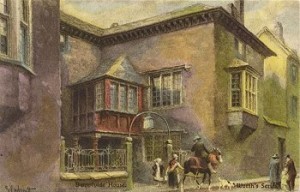 Bampfylde House
Bampfylde HouseThe paintings of the house were done by Robert Dymond, an antiquarian who visited it when it was still there, in 1864. The house has a small courtyard and the front, and a larger one behind, which I make good use of in the novel for Zachary Deane’s sword practice.
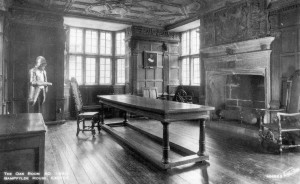 Oak Room, Bampfylde HouseJacobean furniture was massive, heavy and built to last. Often from oak, and built on simple lines, it is characterised by ornate carvings, and friezes of decorative designs. Chairs were probably quite uncomfortable as upholstery was little-used.
Oak Room, Bampfylde HouseJacobean furniture was massive, heavy and built to last. Often from oak, and built on simple lines, it is characterised by ornate carvings, and friezes of decorative designs. Chairs were probably quite uncomfortable as upholstery was little-used.Shutters were used at the mullioned windows to keep in the warmth, and drapes possibly hand-embroidered with crewel work. Here are some examples of crewel work designs from the Victoria and Albert museum. Elspet’s mother may have spent long hours embroidering items such as these, and rubbing them with lavender or sandalwood to keep off moths.
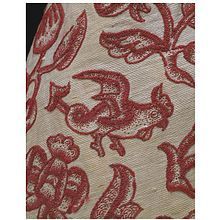
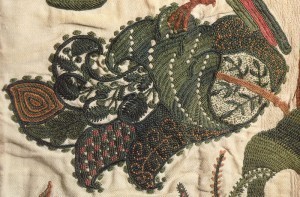 It was crucial to me to have a real sense of what Elspet might lose if she failed to keep her family’s house, so the reader can empathise with that. Re-creating the dark, somewhat structured interior of the house was also vital as a contrast to what Elspet later finds in Spain when she has to pursue her cousin to hot and dusty Seville. At the time Seville is the busiest port in Europe during Spain’s Golden Age, full of new and exciting sights, scents and sounds. There Elspet finds a completely different lifestyle, architecture and customs. Not only that, but she finds a new physical freedom she could never have found in London.
It was crucial to me to have a real sense of what Elspet might lose if she failed to keep her family’s house, so the reader can empathise with that. Re-creating the dark, somewhat structured interior of the house was also vital as a contrast to what Elspet later finds in Spain when she has to pursue her cousin to hot and dusty Seville. At the time Seville is the busiest port in Europe during Spain’s Golden Age, full of new and exciting sights, scents and sounds. There Elspet finds a completely different lifestyle, architecture and customs. Not only that, but she finds a new physical freedom she could never have found in London.By the way, those interested in Jacobean houses might also find this article of interest – how Apethorpe Hall, a Jacobean treasure, was saved by one man.http://www.dailymail.co.uk/home/gardening/article-1085531/The-selfless-man-Britain-How-man-worked-unpaid-20-years-preserve-forgotten-Northamptonshire-palace.html
Picture Credits:Bampfylde House http://demolition-exeter.blogspot.co.uk/2010/09/bampfylde-house-elizabethan-mansion-in.htmlCrewel Embroidery - wikipedia http://www.vam.ac.uk/content/articles/i/english-embroidery-introduction/This article first appeared on The Bookish Librarian Blog
DEAR READERS, MY BLOG HAS NOW TRANSFERRED TO MY WEBSITE www.deborahswift.com please visit me there for further updates!
Published on March 09, 2014 07:13
January 9, 2014
The not-quite-so-swashbuckling duel of Alexandre Dumas
A belated Happy New Year to all my followers. If you did not know, this post is reproduced on my website and blog at www.deborahswift.com, where all my posts are now appearing. I posted here, just in case you missed my previous posts.I had a wonderful Christmas in which I got a whole pile of books, one of which was 'Love Sex Death and Words - surprising tales from a year in literature', by John Sutherland and Stephen Fender. This is a marvellous book about writers past and present, and has a diary entry for each day. Highly recommemded for anyone who loves literature!
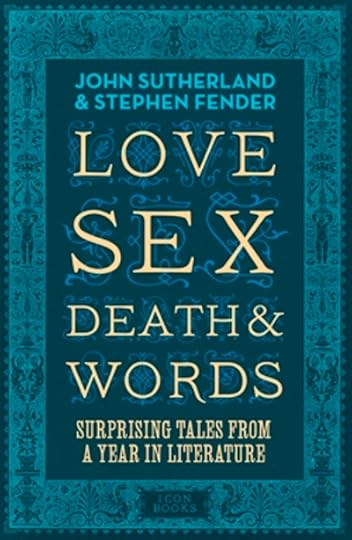 The entry for the 5th January is about Alexandre Dumas, author of The Three Musketeers. Now Dumas has been on my mind recently because of the new blockbuster TV series coming our way this Spring, The Musketeers. The new series stars Luke Pasqualino as d'Artagnan and Maimie McCoy as Milady de Winter. The cast also includes Peter Capaldi and Tom Burke.
The entry for the 5th January is about Alexandre Dumas, author of The Three Musketeers. Now Dumas has been on my mind recently because of the new blockbuster TV series coming our way this Spring, The Musketeers. The new series stars Luke Pasqualino as d'Artagnan and Maimie McCoy as Milady de Winter. The cast also includes Peter Capaldi and Tom Burke.
I can't wait for this, as it ties in nicely with the 17th century swordsmanship I wrote about in A Divided Inheritance. Of course the series is mostly set in France, whereas my book featured a sword school in Spain. But I have always loved swashbuckling films, so this one is definitely on my list.
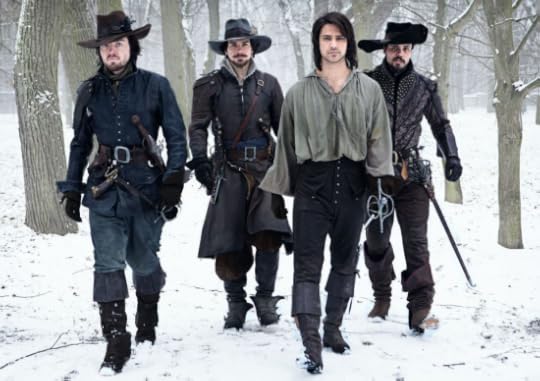 More information and pictures on the BBC website http://www.bbc.co.uk/programmes/galleries/p01mb177
More information and pictures on the BBC website http://www.bbc.co.uk/programmes/galleries/p01mb177
Back to the story about Dumas - In his memoirs he recalls fighting a duel with someone who had criticized his somewhat dandy-ish dress. Initially the duel was to be fought with pistols, in a snow-swept quarry. Later the weapons were changed to swords, but the duel soon fell into farce with his adversary's braces giving way, and Dumas discovering his sword was much shorter than his opponent's. In the event, the dispute was settled when Dumas drew blood. No fight to the death for him.
A colourful character in real life, Dumas was said to have had over forty affairs. He was known to have at least four illegitimate or "natural" children, including a son who shared his name. This son also became a successful novelist and playwright, and was known in France as Alexandre Dumas, fils (son), while the elder Dumas became known as Alexandre Dumas, père (father).
"the most generous, large-hearted being in the world. He also was the most delightfully amusing and egotistical creature on the face of the earth. His tongue was like a windmill – once set in motion, you never knew when he would stop, especially if the theme was himself." Watts Phillips
Once The Musketeers starts, please feel free to chat with me about it on twitter @swiftstory [image error]Alexandre Dumas
 The entry for the 5th January is about Alexandre Dumas, author of The Three Musketeers. Now Dumas has been on my mind recently because of the new blockbuster TV series coming our way this Spring, The Musketeers. The new series stars Luke Pasqualino as d'Artagnan and Maimie McCoy as Milady de Winter. The cast also includes Peter Capaldi and Tom Burke.
The entry for the 5th January is about Alexandre Dumas, author of The Three Musketeers. Now Dumas has been on my mind recently because of the new blockbuster TV series coming our way this Spring, The Musketeers. The new series stars Luke Pasqualino as d'Artagnan and Maimie McCoy as Milady de Winter. The cast also includes Peter Capaldi and Tom Burke.I can't wait for this, as it ties in nicely with the 17th century swordsmanship I wrote about in A Divided Inheritance. Of course the series is mostly set in France, whereas my book featured a sword school in Spain. But I have always loved swashbuckling films, so this one is definitely on my list.
 More information and pictures on the BBC website http://www.bbc.co.uk/programmes/galleries/p01mb177
More information and pictures on the BBC website http://www.bbc.co.uk/programmes/galleries/p01mb177Back to the story about Dumas - In his memoirs he recalls fighting a duel with someone who had criticized his somewhat dandy-ish dress. Initially the duel was to be fought with pistols, in a snow-swept quarry. Later the weapons were changed to swords, but the duel soon fell into farce with his adversary's braces giving way, and Dumas discovering his sword was much shorter than his opponent's. In the event, the dispute was settled when Dumas drew blood. No fight to the death for him.
A colourful character in real life, Dumas was said to have had over forty affairs. He was known to have at least four illegitimate or "natural" children, including a son who shared his name. This son also became a successful novelist and playwright, and was known in France as Alexandre Dumas, fils (son), while the elder Dumas became known as Alexandre Dumas, père (father).
"the most generous, large-hearted being in the world. He also was the most delightfully amusing and egotistical creature on the face of the earth. His tongue was like a windmill – once set in motion, you never knew when he would stop, especially if the theme was himself." Watts Phillips
Once The Musketeers starts, please feel free to chat with me about it on twitter @swiftstory [image error]Alexandre Dumas
Published on January 09, 2014 11:56



